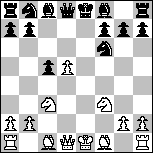
1. e4 e6 2. d4 d5 3. c4 dxe4 4. Nc3 Nf6 5. f3 exf3 6. Nxf3 c5 7. d5 exd5 8. cxd5

8... Bd6
This is the line recommended for Black by Keres.
9. Bd3 Qe7+
After 9... O-O 10. O-O, black can try to play active, 10... Bg4, but after, 11. Bg5 h6 12. Bh4 Nbd7 13. Ne4 Be5 14. Qb3!? it seems a bit of a waste since white threatens b7 and the bishop on e5 followed by exchanging at f6 making gxf6 necessary and weakening the kingside. Black must play Bxf3 and help white double the rooks and lose the bishop pair at the same time. It doesn't help to play 14... Bxf3 15. Rxf3 Bd4+ 16. Kh1 Ne5 because of 17. Nxf6+.
Black can try to play on the queenside, 10... a6, but this attack unravels a bit too slow after 11. Bg5 h6 12. Bh4 Nbd7 13. Ne4 Bb8! (13... Be7 14. d6 +-) 14. Rac1 Ba7 15. Bb1! c4+ 16. Kh1 b5 17. Qc2, and things look bad.
The idea of 9... Qe7+ must be to keep white from playing Ne4 so quickly by drawing the knight back to e2 temporarily. White can then gain tempo back by playing Re1 after castling short but this would take pressure of the f-file.
The Black queen is somewhat misplaced on e7 since it can't accomplish anything there. It is much better placed on c7 where it supports the c4 advance. However, Black hopes that White will make 10. Be2 and lose time.
10. Kd2?!
10. Ne2 Nxd5! 11. Bb5+ Bd7 12. Bxd7 Qxd7! with superior game. 13. Qxd5?? Bg3+.
An awkward move which probably caused the loss of the game. The king now blocks the Bc1 and after 11. Kc2 it is no longer possible to put the queen and Bd3 on the b1-h7 diagonal which is one of White's most powerful attacks.
I don't believe that 10. Be2 is good since it loses too much time and the Rh1 should remain on f1 after castling short.
Instead 10. Kf2!? can be tried where White is ready to play Qc2. Black can advance the c5-pawn to exploit the weakness along the a7-g1 diagonal after taking measures against 11. Re1. A possible continuation is 10. Kf2 O-O 11. Re1 (11. Rf1 c4 12. Bxc4 Bc5+ 13. Nd4 (13. Kg3 Nh5 0-1) Qe5 14. Nce2 (14. Be3 Ng4+) Nxd5 with Black advantage) Qc7 12. Kg1 c4 13. Bb1! Bc5+ 14. Kh1 and then 15. Qc2 although Black now has good play.
White should probably try something else in the 9th move.
10... O-O 11. Kc2 h6
It is necessary to avoid 12. Bg5 when piece play may become complicated due to White's space advantage. The move allows for quite a rapid g2-g4-g5, but Black is prepared to counter with a queenside attack since the White king has moved there. If white had moved 10. Kf2 such an attack would not have been as efficient.
12. h3
12... a6
The "King's Walk Variation" has a typical flavour of castling on opposite sides, although white has castled "by hand". Let's find out who will get the attack launched the quickest.
12... Na6 13. a3 Nc7 14. Re1 Qd8 15. Be3 Nfxd5 16. Nxd5 Nxd5 17. Bh7+ Kxh7 18. Qxd5 Be7 (18... b6? 19. Rad1 Be7 20. Qe4+ f5 21. Qxa8 +-) 19. Qxd8 Rxd8 20. Bxh6 -+.
13. g4 b5 14. g5 hxg5
14... Nh5 15. gxh6 c4 -+ or 14... c4.
15. Bxg5 c4
Black has the edge due to the poor position of the White king.
16. Be4
16.Be2 leads to 16...Bf5+ 17.Kc1 b4 with a nasty position.
16... b4 17. Bxf6
17. Bxf6 takes the pressure of Black. The only alternative is 17. Re1 but if Black ignores the threat against the queen 17... bxc3 18. Bh7+ Kxh7 19. Rxe7 Bxe7 White will have to give a rook and two pieces for the queen. The game, however, becomes extremely complex and perhaps White has small chances to draw the game.
17... Qxf6
17... gxf6?? 18. Rg1+ Kh8 19. Nh4 Qe5 20. Nf5 1-0.
18. Nb1
18. Ne2 Bf5 19. Nd2 Bxe4+ 20. Nxe4 Qf5 0-1.
18... Bf5
White should have resigned now, but I did not want to lose a miniature!
19. Re1
19... Re8 20. Nfd2
The only move! Black loses a piece after 20. Nbd2 c3.
20. Bxf5? Qxf5+ 21. Kc1 Rxe1 22. Nxe1 (almost like in the game Karpov-Kasparov, Linares 1993, where all the White pieces were driven back to the first row) Bf4+ 23. Nd2 c3 0-1.
20... Nd7
20... c3 21. bxc3 bxc3 22. Nxc3 Rc8 23. Re3 Bf4 24. Bxf5 Qxf5+ 25. Rd3 Nd7 26. Qg4 Qxd3+! 27. Kxd3 Ne5+ 28. Ke4 Nxg4 29. Kxf4 Rxc3 30. hxg4 Rd3 0-1.
21. Qf3 Bxe4+ 22. Rxe4 Qxf3 23. Rxe8+ Rxe8 24. Nxf3 Nf6
Black goes after the unprotected pawn.
25. Nbd2 Rc8 26. a3
26. Rd1 Nxd5 27. Ne4 is met by 27... Ne3+.
26... bxa3
26... b3+ 27. Kc3 Nxd5+ 28. Kd4 Nb6 29. Rc1 -+, but White would have a slight hope.
27. bxa3 Nxd5 28. h4 Be7 29. Ne4 Ne3+ 0-1
White resigns since 30. Kd2 Ng2 31. h5 Nf4 32. Ng3 Rc5 33. Rh1 (33. Rc1 Nxh5 34. Nxh5 Rxh5 35. Rxc4 Bxa3) Rd5+ 34. Kc2 (34. Kc3 Rd3+ or 34. Ke3 Ne6 35. Ra1 Rd3+) Bxa3 and Black is three pawns up.